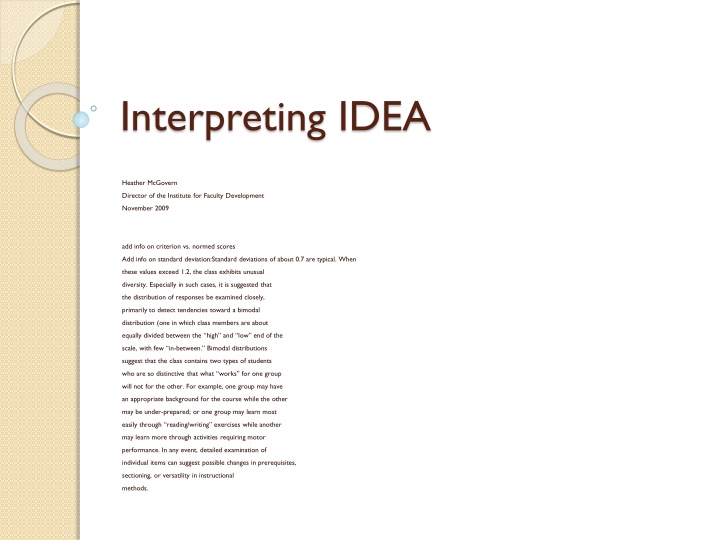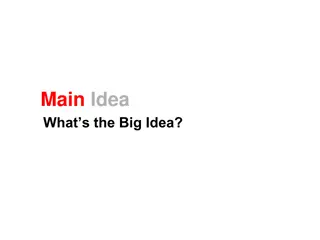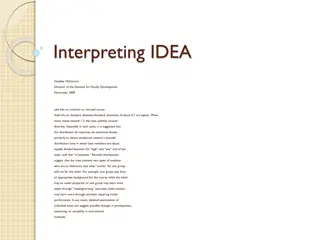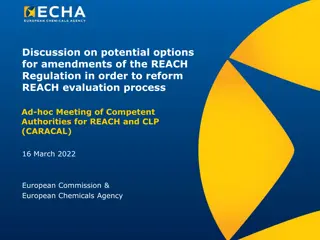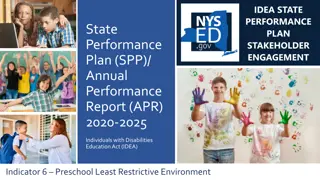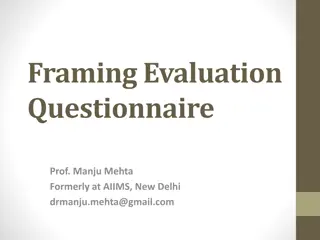Evaluation of Teaching Methods at Stockton: Insights from IDEA and Multiple Measures
Heather McGovern, Director of the Institute for Faculty Development, shared insights on interpreting IDEA data, including criterion vs. normed scores and standard deviation analysis. The appropriate role of IDEA in evaluating teaching at Stockton involves considering validity, reliability, mean scores, halo effect, and faculty selection of objectives. Stockton candidates provide evidence of teaching performance through teaching portfolios. Correlations show how student ratings align with feedback from administrators, colleagues, alumni, and observers.
Download Presentation

Please find below an Image/Link to download the presentation.
The content on the website is provided AS IS for your information and personal use only. It may not be sold, licensed, or shared on other websites without obtaining consent from the author.If you encounter any issues during the download, it is possible that the publisher has removed the file from their server.
You are allowed to download the files provided on this website for personal or commercial use, subject to the condition that they are used lawfully. All files are the property of their respective owners.
The content on the website is provided AS IS for your information and personal use only. It may not be sold, licensed, or shared on other websites without obtaining consent from the author.
E N D
Presentation Transcript
Interpreting IDEA Heather McGovern Director of the Institute for Faculty Development November 2009 add info on criterion vs. normed scores Add info on standard deviation:Standard deviations of about 0.7 are typical. When these values exceed 1.2, the class exhibits unusual diversity. Especially in such cases, it is suggested that the distribution of responses be examined closely, primarily to detect tendencies toward a bimodal distribution (one in which class members are about equally divided between the high and low end of the scale, with few in-between. Bimodal distributions suggest that the class contains two types of students who are so distinctive that what works for one group will not for the other. For example, one group may have an appropriate background for the course while the other may be under-prepared; or one group may learn most easily through reading/writing exercises while another may learn more through activities requiring motor performance. In any event, detailed examination of individual items can suggest possible changes in prerequisites, sectioning, or versatility in instructional methods.
Overview The appropriate role of IDEA in the context of evaluation of teaching at Stockton A. Validity B. Reliability and representativeness Interpreting data A. Mean B. Halo effect C. Error of central tendency D. Faculty selection of objectives I. II. Making comparisons A. IDEA, Stockton, and disciplinary comparisons B. Converted scores C. Adjusted scores D. Norming E. Comparisons to SET data Other things to consider References III. IV. V.
The appropriate role of IDEA in overall evaluation of teaching The IDEA Center strongly recommends that additional sources of evidence be used when teaching is evaluated and that student ratings constitute only 30% to 50% of the overall evaluation of teaching. Primary reasons: o some components of effective teaching are best judged by peers and not students o it is always useful to triangulate information... o no instrument is fully valid o no instrument is fully reliable
What Stockton candidates provide for evaluation of teaching Stockton policy states that evidence of teaching performance should be demonstrated by a teaching portfolio, as outlined below, which should contain the following: A self-evaluation of teaching Student evaluations of teaching and preceptorial teaching Peer evaluations of teaching Other evidence of effectiveness in teaching
Correlations of multiple measures of teaching excellence Student ratings correlate with faculty, alumni, and administrator ratings: Administrator Colleagues Alumni Trained observers Student comments .75 to .93 .39 to .62 .48 to .69 .40 to .70 .50 to .76
Student ratings are valid The validity of student ratings has been checked with correlation studies of multi- section course instructor ratings to external tests. These have indicated validity ratings that are practically useful (between .30 and .49) as follow: Achievement of learning Overall course Overall instructor .47 .47 .44
Students cannot validly rate all important qualities of teaching Of 26 factors Cashin (1989) identifies as relevant to teaching effectiveness, there are eleven which students cannot assess. Keig and Waggoner (1994) grouped these into three categories: (1) the goals, content, and organization of course design, (2) methods and materials used in delivery, and (3) evaluation of student work, including grading practices.
How Stockton defines excellence in teaching and what students rate A thorough and current command of the subject matter, teaching techniques and methodologies of the discipline one teaches Sound course design and delivery in all teaching assignments as evident in clear learning goals and expectations, content reflecting the best available scholarship or artistic practices, and teaching techniques aimed at student learning The ability to organize course material and to communicate this information effectively. The development of a comprehensive syllabus for each course taught, including expectations, grading and attendance policies, and the timely provision of copies to students. respect for students as members of the Stockton academic community, the effective response to student questions, and the timely evaluation of and feedback to students. Where appropriate, additional measures of teaching excellence are Ability to use technology in teaching The capacity to relate the subject matter to other fields of knowledge Seeking opportunities outside the classroom to enhance student learning of the subject matter
False assumptions about IDEA Effective teaching=students make progress on all 12 learning objectives Effective teachers= teachers who employ all 20 teaching methods
Reliability and representativeness
A number of classes are needed to draw accurate conclusions File reviewers should keep in mind that the IDEA Center recommends using six to eight classes, not necessarily all from the same academic year, that are representative of all of an instructor s teaching responsibilities.
The number of student responders affects reliability The number of student respondents affects reliability. In this context, reliability refers to consistency, interrater reliability. Fewer than ten students are unreliable evaluators should pay scant attention to numerical data from classes with fewer than ten respondents. IDEA reports the following median rates: 10 raters .69 reliability 15 raters .83 reliability 20 raters .83 reliability 30 raters .88 reliability 40 raters .91 reliability Reliability ratings below .70 are highly suspect.
The number of student responders affects representativeness Higher response rates provide more representative data. Lower response rates provide less representative data. This is especially an area of concern for classes using the online IDEA which has a lower response rate. Dennis Fotia informs me that in Fall 2008, the response rate was 62.9%. Spring 2009 data: Number of Surveys Processed: 50 Number of Respondents: 1045 Number of Responses: 714 Average Response Rate: 71.5%
Mean scores can be affected by outliers Note that average scores as provided on the IDEA form are mean scores. As such, they can be affected by outliers. Careful evaluators will check the statistical detail on page 4 to note the presence of outliers.
Scores can be affected by the halo effect Ranters and Ravers, or the halo effect the tendency of raters to form a general opinion of the person being rated and then let that opinion color all specific ratings. If the general impression is favorable, the "halo effect" is positive and the individual receives higher ratings on many items than a more objective evaluation would justify. The "halo effect" can also be negative; an unfavorable general impression will lead to low marks "across the board", even in areas where performance is strong.
How can you know? Look at the student forms themselves. If a form gives someone a 5 all the way down halo effect! In most cases, also true with a 1 or any other number all the way down
The Error of Central Tendency can affect scores Most people have a tendency to avoid the extremes (very high and very low) in making ratings. As a result, ratings tend to pile up more toward the middle of the rating scale than might be justified. In many cases, ratings which are "somewhat below average" or "somewhat above average" may represent subdued estimates of an individual's status because of the "Error of Central Tendency.
How faculty select objectives can affect scores The Summary Evaluation provided on page one of the IDEA report weights Progress toward Relevant Objectives at 50% and Excellent Teacher and Excellent Course at 25%. Therefore, evaluators should pay attention to the objectives a faculty member selected.
Things evaluators should check The teacher selected objectives. If not, by default, all will be considered important. This makes most information on the first summary page of the report worthless. The objectives the teacher chose seem reasonable for the course. The teacher discusses problematic objective choices or irregularities in the class.
Consider external factors in objective selection Most of the time at Stockton, the ultimate decisions about objectives are the teacher s choice. However, some (and a growing number of) programs encourage (or for all practical purposes, especially for untenured faculty, require) some objectives to be held in common. This is particularly the case with courses of which there are multiple sections.
Faculty can help evaluators Logically, faculty members creating their files should note if they forgot to select objectives, which seriously impacts the results, later see that they chose objectives poorly., were using objectives in common with a larger group of courses, but those were problematic for their class, or need to report an unusual situation that likely affected student progress towards objectives or student perception of the class.
IDEA compares class results to three groups 1) Three years of IDEA student ratings at 122 institutions in 73, 722 classes (excluding classes with fewer than 10 students, limiting to no more than 5% of database from any one institution, excluding first time institutions) 2) Classes at your institution in the most recent five years (excluding classes with no objectives selected, including classes of all sizes) 3) Classes in the same discipline in the most recent five years where at least 400 classes with the same disciplinary code were rated (excluding as in 1) plus courses with no selected objectives)
The validity of comparisons varies The validity of comparisons depends on a number of factors, including how typical a class is, compared to classes at Stockton or all classes in the IDEA database or how well the class aligns with other classes with the same IDEA disciplinary code. Some classes at Stockton align poorly with typical classes say, a fieldwork class or a class with an cutting-edge format.
External factors can affect comparisons and ratings Students in required courses tend to report lower. Students in lower level classes tend to report lower. Arts and humanities >social science > math (this may be because of differences in teaching quality or due to quantitative nature of courses, both, or other factors). Gender/age/race/culture/height/physical attractiveness and more may be factors, as they are in many other areas of life. If the students are told the evaluation will be used in personnel decisions the scores are higher. If the instructor is present during the evaluation the scores are higher.
Some external factors dont usually affect ratings Time of day of the course Time in the term in which evaluations are given (after midterm) Age of student Level of student Student GPA
Some disciplinary comparisons are suspect Many classes align poorly with disciplinary codes: CRIM stats here, which is compared either with Criminal Justice or with Mathematics. Or developmental writing here, which is higher level than many but also for credit. Or most of our G courses, perhaps particularly our GIS courses.
We should use converted scores IDEA states that Institutions that want to make judgments about teaching effectiveness on a comparative basis should use converted scores.
Why we should use converted scores The 5-point averages of progress ratings on Essential or Important objectives vary across objective. For instance, the average for gaining factual knowledge is 4.00, while that for gaining a broader understanding and appreciation for intellectual/cultural activity is 3.69. Unconverted averages disadvantage broad liberal education objectives. Using converted averages ensures that instructors choosing objectives where average progress ratings are relatively low will not be penalized for choosing objectives that are particularly challenging or that address complex cognitive skills.
Why we should use adjusted averages in most cases Adjusted scores adjust for student motivation, student work habits, class size, course difficulty, and student effort. Therefore, in most circumstances, the IDEA Center recommends using adjusted scores.
How are they adjusted? Work Habits (mean of Item 43, As a rule, I put forth more effort than other students on academic work) is generally the most potent predictor Unless ratings are adjusted, the instructors of such classes would have an unfair advantage over colleagues with less dedicated students.
How are they adjusted, part II Course Motivation (mean of Item 39, I really wanted to take this course regardless of who taught it) is the second most potent predictor. unless ratings are adjusted, the instructors of such classes would have an unfair advantage over colleagues with less motivated students.
How are they adjusted, part III Size of Class is not always statistically significant; but when it was, it was always negative the larger the class, the lower the expected rating.
How are they adjusted, part IV Course Difficulty, as indicated by student ratings of item 35, Difficulty of subject matter is complicated because the instructor influences students perception of difficulty. Therefore, A statistical technique was used to remove the instructor s influence on Difficulty ratings in order to achieve a measure of a class s (and often a discipline s) inherent difficulty. Generally, if the class is perceived as difficult (after taking into account the impact of the instructor on perceived difficulty), an attenuated outcome can be expected. Notable examples: in Creative capacities and Communication skills high difficulty is strongly associated with low progress ratings. In two cases, high difficulty leads to high ratings on progress toward objectives: Factual knowledge and Principles and theories.
How are they adjusted, part V Student Effort is measured with responses to item 37, I worked harder on this course than on most courses I have taken. Here, because response reflects the students general habits and how well the teacher motivated students, the latter is statistically removed from the ratings leaving the fifth extraneous factor, student effort not attributable to the instructor. Usually, student effort is negatively related to ratings. A special case is that in the cases of Classes containing an unusually large number of students who worked harder than the instructor s approach required which get low progress ratings, maybe because people were unprepared for the class or lack self-confidence and so under achieve or under-estimate their progress in a self-abasing manner.
A critical exception to using adjusted scores We recommend using the unadjusted score if the average progress rating is high (for example, 4.2 or higher). In these cases, students are so motivated and hard-working that the teacher has little opportunity to influence their progress, but instructors should not be penalized for having success with a class of highly motivated students with good work habits.
Another exception to using adjusted scores: Assessment of learning In deciding which ratings to use, it is important to consider whether the focus is on student outcomes or on instructor contributions to those outcomes. For the former, Unadjusted ratings are most relevant; for the latter, Adjusted ratings are generally more appropriate.
Do not try to cut the scores more precisely than IDEA does Because the instrument is not perfectly valid or reliable, trying to compare scores within the five major categories IDEA provides is not recommended.
Norming sorts people into broad categories Scores are normed. Therefore, it is unrealistic to expect most people to score above the similar range. Statistically, 40% of people ALWAYS score in the similar range and 30% above and 30% below that range.
More thoughts on norming Many teachers teach well. Therefore, the comparative standard is relatively high. Being similar is not bad. It is fine. If we made a list of 10 teachers at random at Stockton, we d expect that one would fall into the much lower range, two into lower, four into similar, two into higher, and one into much higher if we think Stockton teachers are basically comparable to the teachers in the IDEA database.
Thoughts about comparing to SET data We can t perform the most accurate comparisons of IDEA data to SET data because we don t know the standard of error for the SET. The SET also did not convert or adjust or norm scores. Questions on it were not tested for validity and reliability. Most questions don t compare to the IDEA form (and those that do could be differently influenced by the other questions on the forms).
Mathematical conversion All that said, I ve found what are supposed to be fairly valid equations for adjusting from a 5 point to a 7 point scale and back. That said, research indicates that scales with fewer points (the IDEA compared to the SET) allow for less precise measurement. Apparently this mainly means that because people can t go as much higher, scores tend to be lower even after being converted.
Other items that relate to our definition of excellent teaching Primarily, pages one and two should be used for summative evaluation of teaching. Page 4, which provides raw data, should be at least skimmed to note distribution of scores and for responses to additional questions. Due to our definition of excellence in teaching, we should also attend to item 17 on page 3 ( Provided timely and frequent feedback for summative evaluation.
Items to consider for formative evaluation In cases where evaluators can or choose to provide formative evaluation, page 3 is essential. Here, evaluators should note that effective teaching methods and styles depend upon the learning objectives for the class, and IDEA notes these. IDEA also provides suggestions for areas of strength, areas of weakness, and areas that are ok but have room for improvement. Evaluators can point to these to see what behaviors to recommend or applaud.
Teachers can use page 3 Teachers can look to the information on page three to see what steps they might take to improve student progress on various objectives. See sample report.
References Cashin, William. Student Ratings of Teaching, the Research Revisited. 1995. Idea paper 32. http://www.theideacenter.org/sites/default/files/Idea_Paper_32.pdf Cashin, William. Student Ratings of Teaching: A Summary of the Research. 1988. Idea paper 20. http://www.theideacenter.org/sites/default/files/Idea_Paper_20.pdf Colman, Andrew, Norris, Claire., and Preston, Carolyn. Comparing Rating Scales of Different Lengths: Equivalence of Scores from 5-Point and 7-Point Scales. 1997. Psychological Reports 80: 355-362. Hoyt, Donald and Pallett, William. Appraising Teaching Effectiveness: Beyond Student Ratings. Idea paper 36. http://www.theideacenter.org/sites/default/files/Idea_Paper_36.pdf Interpreting Adjusted Ratings of Outcomes. 2002, updated 2008. http://www.theideacenter.org/sites/default/files/InterpretingAdjustedScores.pdf Pallet, Bill. IDEA Student Ratings of Instruction. Stockton College, May 2006. Using IDEA Results for Administrative Decision-making. 2005. http://www.theideacenter.org/sites/default/files/Administrative%20DecisionMaking.pdf
